#DWDM ITU Channel
Explore tagged Tumblr posts
Text
Introduction to 40GBASE QSFP+ Optical Modules
40GBASE Optical modules are different from optical handsets with a 40Gbps transmission rate, in which the QSFP is the primary structure factor. Also, the 40G QSFP+ Modules are the most extensively applied optical handsets. In this article, 10Gtek will present distinctive organization arrangements of the most overall 40G QSFP+ handsets to assist you with having a simpler understanding and better determination of the modules.
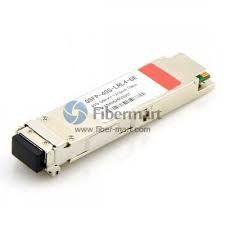
Highlights and Benefits of 40G QSFP+ Transceiver
Hot-pluggable to 40G Ethernet QSFP+ port
QSFP+ MSA consistent and interoperable with other IEEE-agreeable 40G interfaces
RoHS affirmed and checked unrivaled execution, solidness, and dependability
Rapid electrical interface dependent on IEEE 802.3ba agreeable
4 Parallel paths plan of SR4, ESR4, PSM LR4, and PSM IR4
4 CWDM paths MUX plan of LR4, IR4, and ER4
Low force utilization under 3.5W
40G QSFP+ SR4 and 40G QSFP+ ESR4 Transceivers
The signs' conveyance of 40G QSFP+ SR4 handset is sent through four autonomous full-duplex channels. MPO/MTP Connector is a basis applied to the Transceiver in 40G information transmission, and MMF(Multi-Mode Fiber) is needed to work over inside the handset. At the point when it's running over the OM3 optical fiber jumper the transmission separation is 100m, while the scope can be 150m when it's running over the OM4 optical fiber jumper.

40G QSFP+ ESR4 is a similar working rule as 40G QSFP+ SR4 however with an advanced separation of transmission up to 300m over OM4 optical fiber jumper. It tends to be considered as an updated form of 40G QSFP+ SR4 handset.
40G QSFP+ BIDI Transceiver
The QSFP+ BIDI handset is created to address the difficulties of fiber foundation by giving the capacity to send full-duplex 40G traffic more than one duplex MMF link with LC connectors(Figure 2). At the end of the day, this handset upholds 40G association more than one sets of MMF links while permitting 40G to be sent utilizing a similar foundation as 10G (10GBASE-SR) without the need to include any strands.
Examination of 40G QSFP+ BIDI and 40G QSFP+ SR4
40GBASE-SR BIDI handset eliminates 40G cabling cost hindrances in server farm organizations. It gives colossal investment funds and effortlessness contrasted with other 40G QSFP+(MMF) transceiver(QSFP+ SR4). Additionally, it permits associations to move the current 10G cabling framework to 40G at no expense and to grow the foundation with low capital speculation.

40G QSFP+ PSM IR4 and 40G QSFP+ PSM LR4 Transceivers
QSFP+ PSM IR4/LR4 is an exceptionally coordinated four-channel optical handset with the benefits of the high thickness of port and lower cost. The optical port embraces a PSM(Parallel Single Mode) innovation and a four-way equal plan MPO/MTP interface which empowers the transmission separation up to 1.4km of IR4 and 10km of LR4. It has been planned with structure factor, optical/electrical association, and computerized analytic interface consistent with MSA(Multi-Source Agreement), these highlights are very attainable to meet the harshest outer working conditions including temperature, moistness, and EMI interface.
The handset can run through the I2C two-wire sequential interface which is accessible to send and get more intricate control signals and to get computerized symptomatic data. By correlation with 40G QSFP+ SR4, they are both similarly of working yet QSFP+ PSM IR4/LR4 is working over SMF(Single Mode Fiber) that is the equal optical signs are conveyed through eight single-mode strands.
40G QSFP+ CWDM LX4/LR4 Lite/LR4/ER4 Transceiver
Recognized from DWDM for example Thick Wavelength Division Multiplex, CWDM known as Coarse Wavelength Division Multiplex is an inventive innovation for moving a lot of information between locales. It builds transfer speed by permitting distinctive information streams to be sent all the while over a solitary optical fiber organization. Thusly, WDM amplifies the use of fiber and assists with streamlining network speculations.
QSFP+ LX4 is an optical module planned particularly for working over both SMF and MMF with transmission separation of up to 150m on OM4 MMF and 2km on SMF. The focal frequencies of the 4 CWDM channels are 1271nm, 1291nm, 1311nm, and 1331nm as individuals from the CWDM frequency framework characterized in ITU-T G.694.2. There is a duplex LC connector for the optical interface and a 148-pin connector for the electrical interface. For applications over SMF, the handset is utilized as a QSFP+ LR4 Lite module and SMF links are legitimately associated with the LC connectors of the module.

QSFP+ LR4 Lite/LR4/ER4 Module bolsters the connection length of up to 2km, 10km, and 30km individually by working over a standard pair of G.652 SMF with duplex LC connector. Inside the gadget, the 40G Ethernet signals are sent more than four frequencies which are figured out how to multiplex and demultiplex. There are 4 information channels to send flags simultaneously. At the sending side, the 4 channels of optical signs are consolidated together by multiplexer while at getting end there is a breakdown handled into 4 channels of optical signals by the demultiplexer. The module includes high thickness, minimal effort, rapid, huge limit, and low force utilization.
CWDM versus PSM, What's The Difference?
From an optical handset module structure perspective, PSM appears to be more financially savvy since it utilizes a solitary uncooled CW (ceaseless wave) laser which parts its yield power into four incorporated silicon modulators. Additionally, its exhibit fiber coupling to an MTP connector is generally less complex. Nonetheless, from a framework perspective, PSM would be more costly when the connection separation is long, basically because of the way that PSM utilizes 8 optical single-mode filaments while CWDM utilizes just 2 optical single-mode strands.
Tantamount with Third-Party QSFP+
All 10Gtek's 40G QSFP+ Transceiver is benevolently viable with outsider QSFP+ gadget, for example, Cisco, Extreme, Brocade, Juniper, HP, Dell, Arista, Huawei, and other known brands. Our 40G QSFP+ handset will give you a phenomenal answer for set up network association without costly expense.
2 notes
·
View notes
Text
CWDM/DWDM ITU Channel Руководство
CWDM (Грубое Спектральное Мультиплексирование) и DWDM (Плотное Волновое Мультиплексирование) позволяют носителям предоставлять больше услуг по своей существующей волоконной инфраструктуре путем объединения нескольких длин волн на одном волокне. FS предлага��т серию решений и товаров CWDM/DWDM, которые помогают снизить выделение волокон надежным и экономичным способом.
CWDM ITU Channel Обзор
ITU-T G.694.2 определяет длину волны 18 (C1-C18) для CWDM передачи в диапазоне от 1270 до 1610 нм, разнесенных на расстоянии 20 нм. Ниже представлена полная сетка CWDM. Каждый канал CWDM прозрачен для скорости и типа данных, означая, что любое соединение SAN, WAN, голосовых услуг и видеоуслуг может транспортироваться одновременно по одному волокну или паре волокон.
Быстрый Просмотр FS CWDM Оптического Модля
FS CWDM модули доступны со всеми 18 длиной волны CWDM, включая CWDM SFP, CWDM SFP+, CWDM XFP и 3G SDI CWDM SFP модули. Эти трансиверы CWDM могут применяться при передаче данных с 20 до 120 километров.
20KM CWDM Модули
CWDM SFP 20KM
CWDM SFP+ 20KM
CWDM XFP 20KM
3G SDI CWDM SFP 20KM
40KM CWDM Модули
CWDM SFP 40KM
CWDM SFP+ 40KM
CWDM XFP 40KM
3G SDI CWDM SFP 40KM
80KM CWDM Модули
CWDM SFP 80KM
CWDM SFP+ 80KM
CWDM XFP 80KM
120KM CWDM Модули
CWDM SFP 120KM
FS CWDM Mux/Demux Решение
В дополнение к различным модулям CWDM/DWDM, FS также предоставляет широкий спектр модулей CWDM Mux/Demux, который выступает в качестве основного структурного элемента при расширении и обновлении сети. FS CWDM Mux/Demux имеет несколько разных типов в отношении типа линии, номера канала и специальных портов.
DWDM ITU Channel Обзор
ITU G.694.1 стандартный регион DWDM составляет от 1528,77 нм до 1563,86 нм, который находится в основном в диапазоне C. DWDM может иметь интервал длин волн 100 ГГц (0,8 нм) для 40 каналов или интервал 50 ГГц (0,4 нм) для 80 каналов. Ниже показана полная сетка каналов для DWDM 100 ГГц.
Быстрый Просмотр FS DWDM Оптического Модля
FS CWDM модули доступны со всеми 44 длинами волн DWDM, включая DWDM SFP, DWDM SFP+, DWDM XFP и Tunable DWDM модули, которые поддерживают дальность передачи данных макс.до 120 км. Перестраиваемые модули Tunable (DWDM) могут способен поддерживать определенный канал в оптической сети DWDM, позволяя удаленно изменять длины волн в программном обеспечении.
40KM DWDM Модули
DWDM SFP 40KM
DWDM SFP+ 40KM
DWDM XFP 40KM
80KM DWDM Модули
DWDM SFP 80KM
DWDM SFP+ 80KM
Tunable DWDM SFP+ 80KM
DWDM XFP 80KM
Tunable DWDM XFP 80KM
120KM DWDM Модули
DWDM SFP 120KM
FS DWDM Mux/Demux Решение
DWDM Mux/Demux используется в сетях дальнего расстояния, чтобы облегчить истощение волокна и затраты, связанные с запуском нового волокна. Каждый канал DWDM может передать данных макс.до 100G, а расстояния более 1000 километров могут быть достигнуты с использованием оптических усилителей.
CWDM ITU Channel
0 notes
Text
White Paper: CWDM + DWDM = Increased Capacity
One way of increasing capacity in fiber optic links is to add DWDM over existing CWDM
April 2023
by Robert Isaac
Ghostwritten by Scott Mortenson

For years, service providers have been using Coarse Wavelength Division Multiplexing (CWDM) to increase the capacity of fiber optic links. CWDM filters offer up to 18 ITU (International Telecommunication Union) defined wavelengths and has been an ideal way to transport 1Gbps and 10Gbps circuits over a single fiber span.
What we are seeing now seems to be an uphill climb for CWDM applications. There appears to be a bandwidth growth requirement, and decreased support for CWDM from some equipment manufacturers.
With CWDM support from manufacturers dwindling and the need for capacity increasing at an exponential rate, the question becomes “How do we increase the capacity without forklifting the existing CWDM?”
One answer can be using DWDM over the existing CWDM.

Figure 1
The Concept
Because CWDM is built with channels that are spaced 20nm apart and often have a 10-13nm passband per wavelength (see Figure 1 above), DWDM makes a lot of sense. DWDM filters are built with much smaller channel spacing (.4nm/.8nm/1.6nm), so these wavelengths can be combined and will pass through the ~13nm passband of CWDM channel. For this example, we will focus on standard DWDM filter channels that are in the C-Band (1525nm-1565nm) spectrum and 100Ghz-spaced as this is the most common and supported DWDM application.
If it is warranted this same principle can be applied using DWDM channels in the L-Band (1570nm-1610nm) as well as using channels that are only 50Ghz-spaced to increase channel count and density, and be easily supported with tunable SFP+ optics.

Figure 2
Figure 2 shows how cascading DWDM filters over an existing CWDM span would connect. In this example we use a standard, off the shelf, DWDM filter that is equipped with 8 channels (ITU Ch 52-59).

Figure 3

Figure 4
Figures 3 and 4 show how 20 DWDM channels could be added across the 1530nm CWDM port and 30 DWDM channels can be added using the 1550nm CWDM port using C-band channels. We could apply this same philosophy to the 1570nm, 1590, and 1610nm ports as well but would require L-Band DWDM channels which aren’t widely supported today.
The Challenge
Now that we know a standard 8 Channel CWDM can be expanded to include another 50 channels you may be thinking “What are the potential downsides to using DWDM over CWDM?” and that would be a very good question to ask.
This concept has been available for many years and hasn’t become part of the mainstream deployment strategy for many network operators. Why not? The only limitation to using this concept from a performance standpoint is the added insertion loss of having both the CWDM and DWDM filters between the transceivers.

Figure 5
Figure 5 shows the logical end-to-end for 8 channels of DWDM over an existing CWDM connecting two sites 30km apart. To keep losses lower, we will limit the new channels being added to 8 DWDM channels. Understanding that 10G DWDM optics have an overall power budget of 23db, we can see that adding the DWDM filters brings the overall link loss to 21.5db which falls just inside the power budget.
Because DWDM optics are built for longer reaches with higher power budgets �� and CWDM is often used on shorter fiber spans, say under 30km — the insertion loss should be a non-issue. And if the loss is an issue, DWDM channels can be amplified (unlike CWDM), so placing a low-cost EDFA between the CWDM and DWDM filters could help extend the reach well beyond even 30km.
Reluctance to this concept also seems to come from not fully understanding the simplicity of passive WDM or even how to manage the engineering, installation, records, and inventory for having both technologies within the same span. If those challenges can be overcome, overlaying DWDM onto your existing CWDM can be a very efficient and cost-effective way to respond to the exponential need for bandwidth we are facing in today’s technology.
For network operators and service providers who have made a significant investment in CWDM and facing the need for bandwidth growth, this concept should be considered. Passive DWDM filters can be deployed quickly without impacting existing traffic, are a very low-cost alternative to complex active systems, and can equip your network for the future in very short order. Add the operational efficiency of 10G tunable DWDM optics, and this could be a home run for your network.
Demystifying DWDM for the DCI
If it is so easy and inexpensive, why aren’t all the data centers defaulting to using this on every fiber end? Well, that’s where things get a little tricky.
Whenever you say “DWDM” to a Data Networking person (and even some Service Provider engineers), their default reaction tends to go straight for large, complex, and expensive DWDM systems. Like Reconfigurable Optical Add Drop Multiplexing (ROADM) arrangements that are completely automated and perform optical switching, sub-signal aggregation, and even some L2 functions.
The truth is, DWDM is simply the combination and separation of circuits by wavelength — and only a small part of those larger systems. It is the basic technology that allows users to put 40+ distinct circuits on a given fiber, then separate them at the far end to connect to the individual switch ports.
As stated in the previously, this is often done passively, requiring no electrical power, software, annual maintenance agreement, etc. — and at a fraction of the cost of those more complex active systems.
So again, I ask: “Why aren’t more data center interconnects using this technology?”
Well, DWDM system design — or transport engineering — is usually not taught during Data Networking education courses. DWDM or transport are often thought of as completing ways of architecting a network, which means there are usually two camps: You are either a Data Network Engineer, or a Transport Engineer. Either way, one typically needs the other at some point in their network.
This is not to say you don’t need complex, software-controlled transport devices in your network. The truth is you likely do. What we are singling out here are a few applications where you can get what you need: Fiber capacity between two places quickly, inexpensively, and without sending anyone to school to get certified.
These applications can be:
• Point-to-Point Data Center Interconnects (DCI) on leased, or owned fiber. • Connections between campus facilities. • Network facilities between rooms or floors.
Using Passive DWDM can:
• Reduce or eliminate leased or new fiber builds. • Maximize the data rate per-fiber of installed fiber plants. • Drastically reduce Capex cost of high-capacity switches, complex DWDM systems, and reliance on service providers to maintain the connections. • Increase capacity of DCI connections in days not months.
How can we do this in a way we can understand?
It really comes down to Optical Link Engineering.
If you take the physical map of your network and zoom in on one span where there is a capacity bottleneck, it becomes a lot easier. For simplicity’s sake, we will focus on connecting 10G switch ports, across a single span between 2km and 50km long, making the math fairly simple.
For these locations, we just need to focus on two primary factors: Link Budget vs Link Loss, and Dispersion.
Link Budget vs. Link Loss
Every optic or transceiver has a minimum transmit power, and a minimum receiver sensitivity. By subtracting these two values, you are left with the link budget — or the total amount of power loss the signal can experience and still be legible by the receiver.
In a standard connection, you would calculate (or measure) the total loss of the fiber, patch panels, cassettes, and splices between the two optics. And if that is less than the link budget, then it should work . . . right?
Passive DWDM only adds a little more math to the Link Engineering. The optics at each end would need to be specific DWDM optics, and the filters will add more insertion loss at each end — but it is still, pretty much the same math.
For 10G DWDM optics, the link budget is typically in the 23db range. If a fiber span, with DWDM filters, has less than 23db of loss, the link should work. It’s simple math.
Or is it?
Dispersion
Another important factor we account for is Chromatic Dispersion (CD). This is a characteristic of single-mode fiber where, as a signal travels along a fiber route, it spreads out and can arrive at the far end slightly ahead or slightly behind schedule, making it difficult to be deciphered by the receiver.
The optics we are using will also establish how much dispersion it can tolerate before the signal becomes undetectable. This value is typically measured in picoseconds per kilometer per nanometer (ps/km/nm) or even simply by the optic’s distance rating. For instance, a DWDM optic-rated for 80km is often limited to 1360 ps/nm/km of dispersion. This is calculated based on traveling 80km on SMF28 type fiber with a CD rating of approximately 17 ps/nm/km.
So, there you have it. If your link falls inside the specifications defined by the optics on each end, you can deploy passive DWDM to maximize the capacity of your fiber plant, and save loads of time and money.
But what if the span exceeds the link budget or dispersion rating? No problem! The addition of Erbium Doped Fiber Amplifiers (EDFA) — to boost the signal power and/or passive Dispersion Compensation Modules (DCM) to account for excess dispersion between the DWDM filters — can help extend the reach and ensure the optics on each end perform to expectation to years to come.
Often when Transport Engineers speak to Data Network Engineers, it can seem like they are speaking different languages. That is to be expected. Specialized jargon or terminology, approaches to problems, and education can be vastly different.
If what your network truly needs is fiber capacity, lower cost of fiber infrastructure, and flexibility of lightning-fast circuit turn-up, passive and even amplified DWDM networks could be the perfect solution.
The 40-channel, two-fiber DWDM solution using 10g SFP+ optics is a great way to get 400G of capacity for links up to about 60km without the need for amplification or dispersion compensation. But what if you want higher data rates on the link? This is where things get a little tricky.
If we remove coherent optics from consideration due to the expense and complexity of deploying them, we see a pattern emerge. Here is a quick snapshot of the specifications of DWDM optics (non-coherent) we could consider:

Figure 6
That table attempts to remove a bunch of “noise” or complexity in determining if a simple point-to-point two-fiber solution will work. What we see when we review those specs is that as data rate increases, the unmodified reach and power budget both decrease.

Figure 7
Given these values, we can use the optical reach and power budget — along with the logical diagram shown in Figure 7 — to determine how long of a cross-connect we can achieve.
If we assume the 40-channel filter has a high-performance loss of 3db each, the patch panels have a loss of 0.5db each and the fiber loss is 0.25db per km (ITU-T G.657.A1 and G.652.D or better), then we can work backwards to see what the total span distance is per optic/data rate.

Figure 8
Reviewing the numbers in Figure 8, we can see that once you go beyond the 10G data rate, the unmodified reach becomes the limiting factor. For this illustration, we can expect to be able to establish some versatile, yet high-capacity, cross-connects.
We had already reviewed the capacity of a passive 40-channel system using 10Gbps optics and know that it can support 400Ghz worth of capacity. Using the same methodology, we can create links with a total line capacity of 1Tbps @ 25Gbps per channel up to ~15km, 1.6Tbps @ 40Gbps per channel up to ~8.8km, and a 4Tbps total capacity up to ~1.5km in fiber length. Knowing this can help reduce the total number cross-connects needed between any two points.
Also, worth noting: Not all channels need to be the same data rate. If the link distance is designed to work with 100Gbps links (or approximately 1.7km), that same link will be able to support 10G, 25G and 40G channels as well.
Summary
Earlier we mentioned we were “removing a lot of noise” — and then continued to make a great deal of assumptions to come up with these numbers. For instance, Forward Error Correction (FEC) is required and must be available on the host device for the links 25Gbps and higher. We made assumptions about fiber type, used calculated losses for the fiber spans, and assumed the total SFP+, SFP28, QSFP+, and QSFP28 ports were available at each end.
What this proved is that by combining passive filters and DWDM optics, we can increase the capacity as much as 40x per cross-connect pair. All this needs no power (except the switches), can be turned up very quickly, requires only 1RU of rack space (not counting the switches or patch panels), and adds zero latency.
As should be clear by now, this is not meant to be taken as gospel, and every effort should be made to know the optic specifications you are considering, the fiber type of the cross-connect, and have measured fiber loss and dispersion values before deploying.
When planned correctly, your CWDM plus DWDM can mean increased capacity without a big financial outlay. And your network can perform better as well.
0 notes
Text
What is a tunable DWDM Transceiver?
Lasers that have the property of tuning the wavelengths according to the values of the on the ITU grid are called tunable lasers and form the agile class of transceiver modules. The working principle and the capability to produce such a card were available as a technology for many years, but their production deployment was making sense after the develop and mass production of tunable pluggable optics.
The tunable transceivers are developed only for DWDM optical transport technology because of the narrow spacing between ITU grids compared with the WDM technology where spacing is larger. Typically, these tunable optics are for the C-Band with 50GHz spacing. Around 88 different channels can be set with intervals of 0.4nm, which is the 50GHz band
Read the full article here:
0 notes
Text
Everything You Should Know About DWDM
DWDM is the ideal solution for networks that require high speeds, high channel capacity, and the capability of using amplifiers to transmit data across long distances. This article provides some basic information about DWDM.
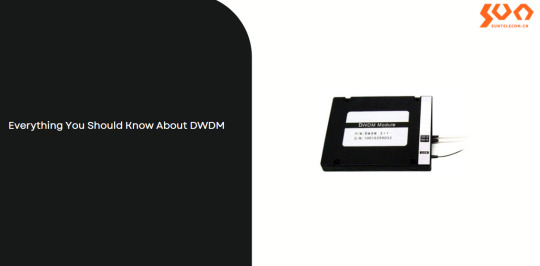
What is DWDM?
Dense wavelength division multiplexing (DWDM) is a wavelength division multiplexing technology used to increase the bandwidth over existing fiber optic networks. The word "dense" here means the wavelength channels are very close to each other. In addition, DWDM works by combining and transmitting multiple signals simultaneously at different wavelengths on the same fiber.
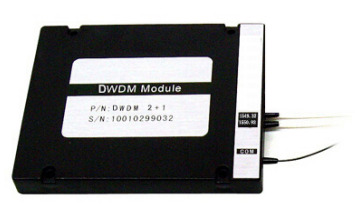
DWDM Operating Principle
According to ITU standards, DWDM has 100GHz (0.8nm) wavelength spacing for 40 channels or 50GHz (0.4nm) spacing for 80 channels.

DWDM System Components
A DWDM system consists of five components: optical transmitters/receivers, DWDM Mux/Demux filters, optical add/drop multiplexers (OADMs), optical amplifiers, and transponders (wavelength converters).
Optical Transmitters/Receivers
Transmitters are described as DWDM components because they provide the source signals which are then multiplexed. The characteristics of optical transmitters used in DWDM systems are highly important to system design. Multiple optical transmitters are used as the light sources in a DWDM system which requires very precise wavelengths of light to operate without interchannel distortion or crosstalk. Several individual lasers are typically used to create the individual channels of a DWDM system. Each laser operates at a slightly different wavelength.
DWDM Mux/Demux
The DWDM Mux (multiplexer) combines multiple wavelengths created by multiple transmitters and operates on different fibers. The output signal of a multiplexer is referred to as a composite signal. At the receiving end, the Demux (demultiplexer) separates all of the individual wavelengths of the composite signal out to individual fibers. The individual fibers pass the demultiplexed wavelengths to as many optical receivers. Generally, Mux and Demux components are contained in a single enclosure. Optical Mux/Demux devices can be passive. Component signals are multiplexed and demultiplexed optically, not electronically, therefore no external power source is required.

Optical Add / Drop Multiplexers
Optical add/drop multiplexers (OADMs) have a different function of add/drop, compared with Mux/Demux filters. OADM is designed to only add or drop optical signals with a particular wavelength. From left to right, an incoming composite signal is broken into two components, drop and pass-through. The OADM drops only the red optical signal stream. The dropped signal stream is passed to the receiver of a client device. The remaining optical signals that pass through the OADM are multiplexed with a new add signal stream. The OADM adds a new red optical signal stream, which operates at the same wavelength as the dropped signal. The new optical signal stream is combined with the pass-through signals to form a new composite signal.
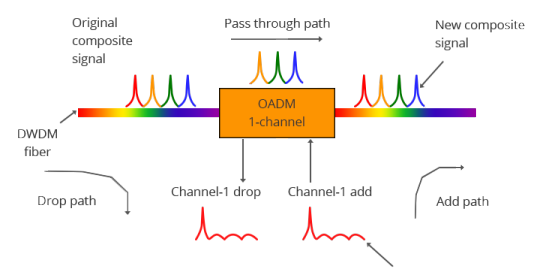
Optical Amplifiers
Optical amplifiers boost the amplitude or add gain to optical signals passing on a fiber by directly stimulating the photons of the signal with extra energy. They are “in-fiber” devices. Optical amplifiers amplify optical signals across a broad range of wavelengths, which is very important for DWDM system applications.
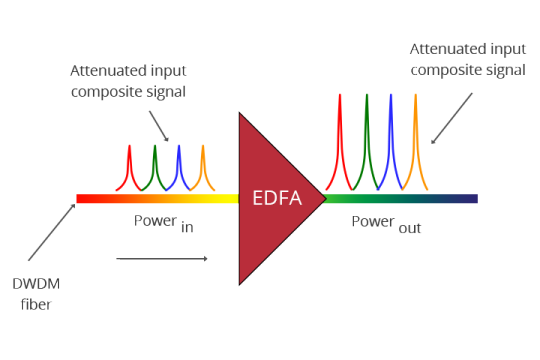
Transponders ( Wavelengths Converters)
Transponders convert optical signals from one incoming wavelength to another outgoing wavelength suitable for DWDM applications. Transponders are optical-electrical-optical (O-E-O) wavelength converters. A transponder performs an O-E-O operation to convert wavelengths of light. Within the DWDM system, a transponder converts the client optical signal back to an electrical signal (O-E) and then performs either 2R (reamplify, reshape) or 3R (reamplify, reshape and retime) functions.

Features and Benefits
DWDM provides low insertion loss, low cost, wide pass band, high channel isolation, high speed, high bandwidth, high stability, high reliability, high flexibility, epoxy free on the optical path, small size, and ease of installation and deployment.
Applications
DWDM is used in channel add/drop, wavelength routing, fiber optic amplifiers, CATV systems, broadband systems, telecommunications networks, metro networks, sensor networks, remote radar networks, data centers, test equipment, etc.

Conclusion
DWDM provides the bandwidth for large amounts of data, high speed, high reliability, and high stability. It is widely used in voice, video, data, etc. Sun Telecom specializes in providing one-stop total fiber optic solutions for all fiber optic application industries worldwide. Contact us if any needs.
1 note
·
View note
Text
DWDM Mux Demux
https://www.optical-sintai.com/products/dwdm-mux-demux/
01- 4CH DWDM Mux Demux
DWDM Mux Demux is usually used for long-haul transmission where wavelengths are packed tightly together over the C-band, up to 48 wavelengths in 100GHz grid(0.8nm) and 96 wavelengths in 50GHz grid(0.4nm).
02- 8CH DWDM Mux Demux
The 8-Channel DWDM MUX-DEMUX module provides multiplexing and demultiplexing for up to 8 DWDM wavelengths in a single-wide module. All wavelengths fall within the pass-band of a C band channel, allowing the module to be used in DWDM applications to increase the number of wavelength circuits.
03- 16CH DWDM Mux Demux
16 Channels Double Fiber Passive 100 GHz DWDM Mux/Demux is a member of the sentai Optics DWDM Series product line. We designed Sintai Optics DWDM Series products to allow easy, gradual, logical, and cost-efficient expansion of network bandwidth using industry-leading passive WDM technology.
04- 18CH DWDM Mux Demux
The DWDM multiplexer/demultiplexer launched by Guangzhou Sintai Communication Co., Ltd. is designed for multi-wavelength DWDM network applications. It works on an ITU grid with 100 GHz channel spacing based on thin-film filter (TFF) technology.

0 notes
Text
Do you know The difference between CWDM transceiver and DWDM transceiver?
Do you know The difference between CWDM transceiver and DWDM transceiver?
DWDM technology multiplexes the tight spectral spacing of a single optical fiber carrier in a given fiber to take advantage of the transmission performance that can be achieved. DWDM wavelength spacing is very tight, because the closer the spacing is, the more channels per fiber will be reused, and thus the higher the bandwidth. The international telecommunication union (ITU) g. 694.1 standard…
View On WordPress
0 notes
Text
Optical Transport Network (OTN) Market Research Report - Global Forecast till 2025
Optical Transport Network (OTN) Market Research Report - Global Forecast till 2025
Market Snapshot
Optical Transport Network (OTN) market , an ITU standard commonly known as "digital wrapper" is a next-generation industry-standard protocol providing an efficient & globally accepted way to multiplex services onto optical light paths. The optical network helps provide a flexible, scalable, and robust Optical Transport Network that helps in catering to a variety of client signals for the expansion of equally varied service requirements including SONET/SDH, PDH, ATM, and Fiber Channels. It is a set of Optical Network Elements (ONE) connected by optical fiber links, which is able to provide the functionality of multiplexing, transport, management, switching, supervision, and survival of optical channels carrying client signals.
OTN plays a vital role in making the network an open and programmable platform, empowering transport to become as significant as computing and storage in intelligent data center networking. Today, a large portion of the system traffic is packet-based, generated by a multitude of services and applications in unpredictable traffic patterns, with widely varying and more stringent demands on bandwidth and data transmission performance. Furthermore, undertaking organizations need high speeds, unwavering quality, and high uptime for information. Consequently, they are continually looking for ideal system arrangements. To avoid losses, companies rely on high-speed optical transport networks to deal with system failures.
Request a Free Sample @ https://www.marketresearchfuture.com/sample_request/1591
Key Developments
In March 2020, nCipher Security LLC inaugurated its new office in the Netherlands. With this, the company can serve the customers as well as their associates in and around the region.
In February 2020, nCipher Security LLC has signed an agreement with DNA Connect, a leading specialist distributor of security solutions in Australia to provide data protection and cybersecurity solutions across Australia and New Zealand.
In November 2019, Aten International Co. Ltd. introduced two new models of presentation switched- VP1420 4 x 2 True 4K Presentation Matrix Switch, and VP1421 4 x 2 True 4K Presentation Matrix Switch with Scaling, DSP, and HDBaseT-Lite. These models will aid consumers in boosting the impact of any professional presentation in small to medium-sized meeting rooms and educational spaces.
In November 2019, Aten International Co. Ltd. announced the launch of the additional implementation of the VE8900/VE8950 Control App to its VE89 Series of AV over IP solutions.
Regional Analysis
· Geographically, the global optical transport network (OTN) market has been segmented into the Asia-Pacific, North America, Europe, the Middle East & Africa, and South America.
· North America is the market leader for the optical transport network market. This is mainly due to factors such as the rising implementation of high-speed communications network technologies. Other reasons influencing the market growth include higher maturity in the market when compared to the other regional markets, growing demand for mobile phones and internet, and data center based operations. The countries included in this research report include the US, Canada, and Mexico.
· The optical transport network market in the US is projected to grow at a substantial rate mainly due to the presence of key market players such as Huawei Technologies Co., Ltd., Infinera, Advanced Micro Devices, Inc., and Ciena Corporation. Factors driving the US market growth are the presence of a large number of network device manufacturers and solution providers in the region, an increasing number of data centers, and adoption of OTN technology by telecom operators. With the provision of extended bandwidth of up to 100 Gigabits per second, Huawei’s DWDM technology-based solution is attracting more and more telecom network operators.
Get complete report @ https://www.marketresearchfuture.com/reports/optical-transport-network-market-1591
About Market Research Future:
At Market Research Future (MRFR), we enable our customers to unravel the complexity of various industries through our Cooked Research Report (CRR),Half-Cooked Research Reports (HCRR), Raw Research Reports (3R),Continuous-Feed Research (CFR), and Market Research & Consulting Services.
Contact:
Market Research Future
Office No. 524/528, Amanora Chambers
Magarpatta Road, Hadapsar
Pune – 411028
Maharashtra, India
+1 646 845 9312
Email: [email protected]
0 notes
Text
Overview of CWDM vs DWDM
As we know, WDM (wavelength-division multiplexing) is a technology that can multiplex a number of optical carrier signals into a single optical fiber by using different wavelengths of laser light. Since there is a tremendous demand for high bandwidth, WDM becomes popular in the market. There are two key types of WDM technologies: CWDM (coarse wavelength division multiplexing) and DWDM (dense wavelength division multiplexing). Then, what are they? What’s the difference between them? This article will have a brief overview of CWDM vs DWDM to help you understand the differences between CWDM and DWDM technology.
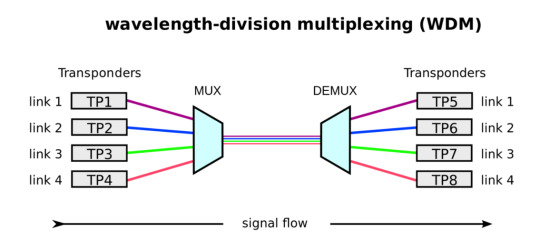
What Is CWDM Technology?
CWDM (coarse wavelength division multiplexing) is a wavelength multiplexing technology for cities and access networks. The word “coarse” means the wavelength spacing between channels is relatively large. In general, CWDM has 18 different channels with a wavelength range from 1270 nm to 1610 nm. Because of the high data rates and low cost, CWDM is widely used in large campuses and data centers. Hence, it has become the preferred method for increasing the bandwidth of metro and optical access networks at a low cost.

What Is DWDM Technology?
DWDM is an optical multiplexing technology used in fiber optics to increase the bandwidth, which resembles CWDM technology. The word “dense” here means the wavelength channels are very close to each other. According to ITU regulations, DWDM has 100GHz (0.8nm) wavelength spacing for 40 channels or 50GHz (0.4nm) spacing for 80 channels. Because of its ability to handle so much data, DWDM is widely used in telecommunications and cable companies and becomes an integral part of their core networks gradually.

CWDM vs DWDM: What Are Their Differences?
Both CWDM and DWDM use multiplexed wavelengths of laser light to increase bandwidth capacity. However, they still have a lot of differences given the following aspects: channel spacing, transmission distance, modulation laser and cost. Just read on to find the details.
Channel Spacing
From the words “coarse” and “dense”, we can see the difference in channel spacing that CWDM has a wider spacing than DWDM. CWDM can provide 18 wavelengths (from 1270 nm to 1610 nm) with the channel spacing of 20 nm. While DWDM can carry 40, 80 or even 160 wavelengths (from 1563.86 nm to 1528.77 nm) with a narrow wavelength spacing of only 1.6, 0.8 or even 0.4 nm. It is simple to see that DWDM has a better performance than CWDM when transmitting a greater number of multiplexed wavelengths on a singer fiber.
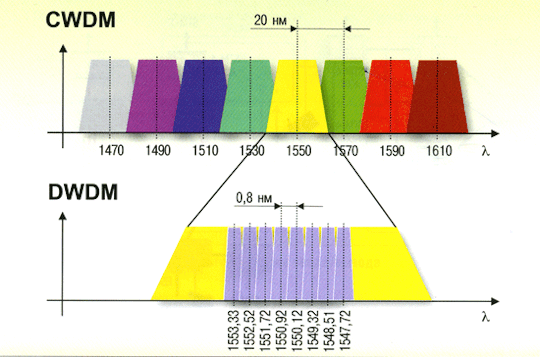
Transmission Distance
DWDM technology is able to have a long transmission by keeping the wavelength highly integrated. The amplified wavelengths can make DWDM suffer less interference over a larger run of cable. Unlike DWDM technology, CWDM can’t travel unlimited distance as the wavelengths are not amplified. Usually, CWDM can transmit data up to 160 km.
Modulation Laser
DWDM technology uses the cooling laser, which is a technology that atomic and molecular samples can be cooled down to near absolute zero. Conversely, CWDM technology uses the uncooled laser, which can’t ensure better performance, higher safety, and long life span like DWDM.
Cost
Generally, the price of DWDM is four or five times higher than that of CWDM. The higher cost of DWDM mainly contributes to cooling laser technique which can realize the temperature tuning. But nowadays, as DWDM technology becomes more and more popular, the price of DWDM transceiver becomes cheaper than CWDM transceiver.
A detailed comparison between CWDM and DWDM technology is in the table below.

Conclusion
From the introduction of CWDM vs DWDM, we know that CWDM and DWDM are two technologies based on WDM technology with different wavelength patterns and applications. Usually, CWDM costs less and its performance is far behind DWDM. Both the cost and requirement should be taken into consideration. You’d better think twice before choosing a CWDM or DWDM system.
0 notes
Text
Wavetek Acterna JDSU MTS-5100e 5073 WDM
Welcome to a Biomedical Battery specialist of the Acterna Battery
New and enhanced network services require increased bandwidth, leading the communications industry to expand its test requirements. Advanced test and measurement needs call for advanced equipment, allowing craftsmen to perform multiple functions with a single test instrument. MTS 5100 is at the forefront of new OTDR technology.
The MTS 5100e and 5200e with battery like JDSU GPDR204 Battery, JDSU LI204SX Battery, JDSU MTS-6000 Battery, JDSU LI204SX-60A Battery, JDSU LI204SX-66A Battery, JDSU LI204SX-60 Battery, HP VA7100 Battery, HP VA7110 Battery, HP VA7400 Battery, HP VA7410 Battery, Biocare ECG-9803 Battery are the ideal platforms for outside plant applications. Equipped with the 5073 WDM module, the MTSe is the perfect tool to maintain DWDM networks. Optimized for field use (lightweight with 3.5 kg, up to 16 hours of operation and with no moving parts), it provides all test parameters to analyze the quality of a DWDM network of up to 10 Ghz channel spacing.
The WDM module is a new member of the family of MTSe modules, which include the essential tools for installation and maintenance of fiber optic links : OTDR, loss test set, Visual Fault Locator, talk set.
Switching between functions takes only seconds, enabling the user to concentrate on measurement or results, rather than on instrument configuration. The MTSe platform is the only unit able to measure fiber optic parameters and WDM parameters within seconds, without the need to swap modules.
Ready for Comprehensive Measurements and Statistical Analysis
Configurable user interface The intuitive interface of the 5073 WDM module is highly user-configurable. Measurement units (nm or THz), SNR measurement set-up (left, right, left and right or custom) and grid (ITU or manual) are user-specified, and channels can be sorted by number, wavelength, power level or OSNR.
Comprehensive measurements In addition to the main DWDM parameters which are measured automatically at the touch of a button, the 5073 WDM module can be used to compare total or partial optical power, level, wavelength, gain tilt and gain slope between two points. An innovative overlay function makes it easy to compare stored waveforms.
Statistical Analysis The 5073 WDM module can be used for statistical analysis of the results of longterm monitoring. User-defined limits identify potential problems, for effective preventative maintenance of the network.
File Management The 5073 WDM module has a comprehensive file management system, which allows successive files to be named and stored automatically, semi-automatically or manually.
0 notes
Text
Functional Modules and Signal Flow (Relay Mode) for Huawei TN54NS4 Boards
The NS4 board implements the regeneration of one channel of optical signals. The wavelengths at the receive and transmit ends of the board are the ITU-T G.694.1-compliant DWDM wavelengths that carry OTU4 optical signals.
The optical receiving module receives the optical signals to be regenerated through the IN optical interface, and performs O/E conversion.
The signal processing module performs decoding, overhead processing and encoding of signals. During the process, the reshaping, regenerating and retiming based on electrical signals are performed, and the signals are encapsulated into OTN frames.
After encoding, the signals are sent to the optical transmitting module. After performing E/O conversion, the module sends out the OTU4 signals at DWDM standard wavelengths that comply with ITU-T G.694.1.
TN54NS4T01
The optical signals are output through the OUT optical interface.

0 notes
Text
What is a tunable DWDM Transceiver?
Lasers that have the property of tuning the wavelengths according to the values of the on the ITU grid are called tunable lasers and form the agile class of transceiver modules. The working principle and the capability to produce such a card were available as a technology for many years, but their production deployment was making sense after the develop and mass production of tunable pluggable optics.
The tunable transceivers are developed only for DWDM optical transport technology because of the narrow spacing between ITU grids compared with the WDM technology where spacing is larger. Typically, these tunable optics are for the C-Band with 50GHz spacing. Around 88 different channels can be set with intervals of 0.4nm, which is the 50GHz band
Read the full article here:
0 notes
Text
CWDM: What You Need to Know
Wavelength division multiplexing (WDM) is a technology for transporting large amounts of data between sites. It increases bandwidth by allowing different data streams to be sent simultaneously over a single optical fiber network. There are two main types of WDM systems: coarse wavelength division multiplexing (CWDM) and dense wavelength division multiplexing (DWDM). This article provides some knowledge about CWDM.
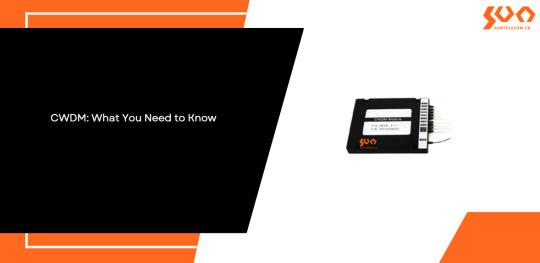
What is CWDM?
Coarse Wavelength Division Multiplexing (CWDM) is a wavelength multiplexing technology for cities and access networks. The word coarse means the wavelength spacing between channels is relatively large. Furthermore, CWDM is an ideal solution for short-range applications and is used to improve the transmission capacity of optical fiber and the utilization of optical fiber resources.

CWDM Operating Principle
CWDM was standardized by the ITU-T G.694.2 based on a grid or wavelength separation of 20 nm in the range of 1270-1610 nm. It can carry up to 18 CWDM wavelengths over one pair of fibers. Each signal is assigned to a different wavelength of light. Each wavelength does not affect another wavelength, so the signals do not interfere. Each channel is usually transparent to the speed and data, so the voice, video, and other services can be transported simultaneously over a single fiber or fiber pair.
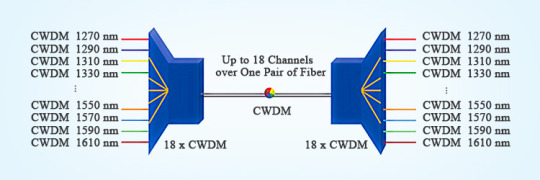
CWDM Network Component
A multiplexer (Mux) combines multiple wavelength channels on a single fiber, and a demultiplexer (Demux) separates them again at the other end. A Mux/Demux set-up is used to increase the end-to-end capacity of a deployed fiber. The Mux is located in the central office, and the Demux is located in the cabinet or splice closure from which the fibers go to their destination in a star-shaped topology.

Features and Benefits
CWDM provides low insertion loss, low polarization-dependent loss, low cost, low-temperature sensitivity, low power consumption, high channel isolation, high data rate, high stability, high reliability, small size, and ease of installation and deployment.
Applications
CWDM is used in metropolitan area networks (MAN), local area networks (LAN), storage area networks (SAN),10-gigabit ethernet, passive optical networks (PON), WDM transmission systems, FTTx networks, 5G front-haul, data centers, online monitoring, fiber optic amplifier, etc.

Conclusion
CWDM has become the preferred solution for increasing the bandwidth of metro/regional and optical access networks. And it has proven to be sufficiently robust, low-cost, and reliable for upgrading the optical network to accommodate future growth. Sun Telecom specializes in providing one-stop total fiber optic solutions for all fiber optic application industries worldwide. Contact us if any needs.
1 note
·
View note
Text
WHAT IS A TUNABLE DWDM TRANSCEIVER?
Lasers that have the property of tuning the wavelengths according to the values of the ITU grid are called tunable lasers and form the agile class of transceiver modules. The principle of operation and the ability to make such a card was available as technology for many years, but its production use made sense after the development and mass production of tunable pluggable optics. The tunable transceivershave only been developed for the optical transport technology DWDM, since the distance between the ITU networks is very small compared to WDM technology, where the distance is larger. Typically these tunable optics are for the C-band with 50GHz spacing. About 88 different channels can be set at intervals of 0.4nm, the 50GHz band
Read the full article here:
https://www.gbic-shop.de/blog/de/96-transceiver/390-was-ist-ein-abstimmbarer-dwdm-transceiver.html.
0 notes
Text
100G OTN Muxponder
https://www.optical-sintai.com/products/100g-otn-muxponder.html
OTNS8600 100G OTN is a 10x10G service convergence platform launched by Sintai Communication Co., Ltd. It uses industry-leading chip technology, supports OTN related standards and can converge any 10-channel 10G services into 1-channel 100G services.
100G OTN Muxponder Features
l Muxponder Mode for Aggregation Services 10x8/10G into 100G OTU4 DWDM Lineside
l 100G Transponder and Regenerator Mode Optional
l Client-side supports 10G LAN/WAN, 8G/10G FC, STM64/OC192, OTU2, OTU2e, 100GbE
l Standards-based ITU-T G709 RSFEC, I.4, I.7
l Supports full C-band DWDM and Coherent CFP for line side
l Performance Monitoring
l Remote management with 2x OSCs and 1x1000Base- T port
l Automatic Laser Shutdown(ALS) for all ports
100G OTN Muxponder Applications
The 100G pluggable card in OTNS8600 chassis is Sintai 100G Multi-protocol Muxponder/Transponder/Regenerator for high capacity transport solutions, it allows migration exist various and future services without replacement.
100G OTN Muxponder Application Scenarios
l Data Center interconnection(DCI)
l Metro Network Application
l High Capacity and Long Haul Solution
l Enterprise Line
100G OTN Muxponder Technical Specifications
Operation Mode
Muxponder Mode
10x 8/10G client and 1x 100G CFP line side
10G Ports
Number of port
10
Interface
10xSFP+
Transceiver
The wavelength, Protocol, Distance depend on SFP+
Protocol
Ethernet 10GbE-LAN/WAN SDH/SONET STM64/OC192
Storage 8G/10G FC G.709 OTN OTU2, OTU2e
100G Ports
Number of port
1
Interface
CFP
Transceiver
DWDM CFP or Coherent CFP, Tunable wavelength
Protocol
100GbE
100G OTN OTU4
FEC Feature(Optional)
FEC function
10G FEC: RSFEC(G.709 FEC), I.4, I.7
100G FEC: RSFEC(G.709 FEC)
100G Coherent CFP: SD-FEC
FEC gain(dB)
10.8 Max with Coherent CFP
Performance Monitoring
Optical module
TX/RX power level, wavelength, temperature
Ports
OTU Section OTU Far Section ODU Path
ODU Far Path OTN FEC Correct error
OTN FEC uncorrected error
Diagnostic test
Loopback
Facility loopback: local loopback, remote loopback
PRBS test
Supports
Protection
Line Protection
Work with OTNS8600 OLP additional
Management
OSC out of band
2xOSCs, 1000BaseFx SFP
Ethernet port
1x10/100/1000Base-T, RJ45
Local craft
1xRS232, USB
Management protocol
SNMPv2, CLI(Telnet/SSH), web-based GUI
Environmental
Operating Temperature
-5 to 50℃
Operating Humidity
5 to 95% (non-condensing)
Storage Temperature
-20 to +85℃
Mechanics
Card type
Pluggable
Platform
OTNS8600, 1-slot 2RU 19" chassis with pluggable fan card
Dimensions (H x W x D mm)
88 x 437 x 230
Power Supply
Card type
pluggable power supply
Power feed
Dual Redundant -48V DC
Power Consumption
240W MAX

1 note
·
View note
Text
Сколько Типов модулей SFP Вы Знаете
Сколько типов модулей вы знаете? Да, я знаю. Из FS.COM, я нахожу этот ответ. Волоконно-оптические трансиверы имеют полный спектр оптических SFP. FS.COM предоставляет различные типы оптических SFP, которые 100% совместимые с Cisco SFP, HP SFP, Juniper SFP, Netgear SFP, DELL SFP, CWDM SFP, SFP DWDM , BIDI SFP, 10G SFP и т. д. Существует так много типов трансивера SFP, я буду подробнее представлять несколько типов оптических SFP.
Первые типы оптических SFP: CWDM SFP
CWDM SFP (small form-factor pluggable) - это действительно компактный оптический модуль, используемый в оптических связях для телекоммуникационных и коммуникационных приложений на длине волны. CWDM SFP используются для соединения портов с оптической сетью, типичный CWDM SFP как Cisco CWDM SFP может поддерживать Gigabit Ethernet и Fibre Channel. Модули трансиверов CWDM SFP используют интерфейс оптический SFP для подключения оборудования и ��войной волоконный интерфейс разъема LC PC для подключения к оптической сети. CWDM SFP модули могут быть найдены с различными типами передатчиков и приемников, что позволяет пользователям выбирать соответствующий трансивер для каждой линии связи для предложения требуемого оптического диапазона по доступному оптическому волокну.
Второй тип оптических SFP: SFP DWDM
Плотное Мультиплексирование (с разделением) по Длинам Волн (DWDM) предлагают DWDM транспорт с значительно меньшей мощностью и стоимостью в стандартном упаковке оптических SFP. SFP DWDM доступен на всех длинах волн C/L-полосы длин волн на сетке ITU DWDM. В качестве многолинейных интерфейсов они поддерживают любой протокол от 100 Мбит/с до 4,25 Гбит/с. Модули отвечают требованиям стандарта IEEE802.3 Gigabit Ethernet и спецификациям ANSI Fibre Channel, они подходят для взаимосвязях в средах Gigabit Ethernet и Fibre Channel. SFP DWDM предназначен для приема DWDM SONET/SDH (с или без FEC) для 200 километровых соединений и трафика протокола Ethernet /Fibre Channel для 80 километровых соединений.
Третий тип оптических SFP: SFP 10G
Модули трансивера SFP 10G относятся к молулям 10G SFP Plus, кто-то знает, что SFP 10 представляет собой усовершенствованную версию оптического SFP, поддерживающую скорость передачи данных макс.до 10 Гбит/с. Было выпущено несколько стандартов для SFP 10G, 10GBase-SR подходит для многомодового оптического волокна OM3, соответствующего SFP plus рабочее расстояние до 300 метров, 10GBase-LR подходит для одномодового оптического волокна, соответствующий SFP plus рабочее расстояние 10 км, 10GBase-LRM подходит для FDDI многомодового волокна, SFP plus рабочее расстояние 220 метров.
Хотите узнать больше типов оптических SFP, посетите мой блог, я продолжаю обновлять информацию о волоконно-оптичеком модуле.
0 notes